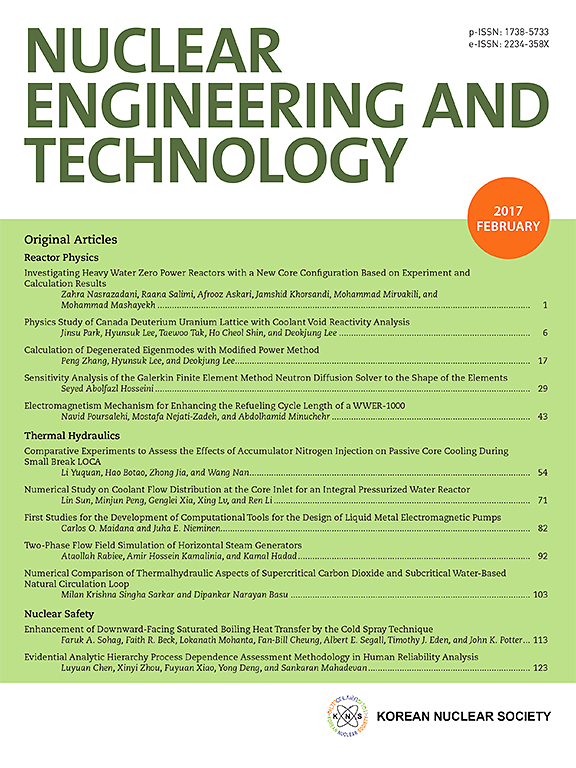北欧重水反应堆压力抑制池热分层和混合的 CFD 模拟
IF 2.6
3区 工程技术
Q1 NUCLEAR SCIENCE & TECHNOLOGY
引用次数: 0
摘要
沸水反应堆(BWR)采用压力抑制池(PSP)作为散热器,以防止反应堆容器和安全壳超压。蒸汽可在正常和事故条件下通过喷射器注入 PSP,在发生冷却剂损失事故(LOCA)时通过排污管道注入 PSP。PSP 的最高温度有安全限制,在此温度下注入蒸汽可能会对安全壳结构造成动态载荷。如果热层温度迅速升高,而冷层仍处于静止状态,形成热分层,那么水池的性能就会受到影响。模拟实际事故情况下的水池行为需要经过验证的模型,这些模型应能充分解决各种现象、安全系统和操作程序之间的相互作用。由于需要同时解决单个蒸汽气泡的最小空间和时间尺度以及整个 PSP 的尺度问题,因此直接模拟蒸汽注入水池的长期瞬态过程计算成本高昂。为使 PSP 分析达到实用目的,有人提出了有效热源和有效动量源(EHS/EMS)模型,以避免解决蒸汽-水界面问题。本文旨在采用作者之前开发的机理方法,模拟北欧 BWR PSP 中通过喷射器注入蒸汽引起的瞬态热分层和混合现象。采用 "单元单元 "方法的最新版 EHS/EMS 模型已经过整体效应池试验验证,并应用于电厂模拟。模拟了与假定事故序列相对应的边界条件的几种情况,以研究分层发展的可能性以及不同系统(如排污管道、高动量喷嘴)的启动对水池行为的影响。本文章由计算机程序翻译,如有差异,请以英文原文为准。
CFD simulation of thermal stratification and mixing in a Nordic BWR pressure suppression pool
Boiling Water Reactor (BWR) employs the Pressure Suppression Pool (PSP) as a heat sink to prevent overpressure of the reactor vessel and containment. Steam can be injected into the PSP through spargers in normal and accident conditions and through blowdown pipes in case of a loss of coolant accident (LOCA). There is a safety limit on the maximum PSP temperature at which such steam injection might cause dynamic loads on the containment structures. The performance of the pool can be affected if thermal stratification is developed when temperature of the hot layer grows rapidly while cold layer remains inactive. Simulation of pool behavior during realistic accident scenarios requires validated models that can sufficiently address the interaction between phenomena, safety systems and operational procedures. Direct modeling of steam injection into a water pool in long-term transients is computationally expensive due to the need to resolve simultaneously the smallest space and time scales of individual steam bubbles and the scales of the whole PSP. To enable PSP analysis for practical purposes, Effective Heat source and Effective Momentum source (EHS/EMS) models have been proposed that avoid the need to resolve steam-water interface. This paper aims to implement mechanistic approaches previously developed by authors for the simulation of transient thermal stratification and mixing phenomena induced by steam injection through spargers in a Nordic BWR PSP. The latest version of the EHS/EMS models using the ‘Unit cell’ approach has been validated against integral effect pool tests and applied to plant simulations. Several scenarios with boundary conditions corresponding to postulated accident sequences were simulated to investigate the possibility of stratification development and the effects of activation of different systems (e.g., blowdown pipes, high momentum nozzle) on the pool behavior.
求助全文
通过发布文献求助,成功后即可免费获取论文全文。
去求助
来源期刊

Nuclear Engineering and Technology
工程技术-核科学技术
CiteScore
4.80
自引率
7.40%
发文量
431
审稿时长
3.5 months
期刊介绍:
Nuclear Engineering and Technology (NET), an international journal of the Korean Nuclear Society (KNS), publishes peer-reviewed papers on original research, ideas and developments in all areas of the field of nuclear science and technology. NET bimonthly publishes original articles, reviews, and technical notes. The journal is listed in the Science Citation Index Expanded (SCIE) of Thomson Reuters.
NET covers all fields for peaceful utilization of nuclear energy and radiation as follows:
1) Reactor Physics
2) Thermal Hydraulics
3) Nuclear Safety
4) Nuclear I&C
5) Nuclear Physics, Fusion, and Laser Technology
6) Nuclear Fuel Cycle and Radioactive Waste Management
7) Nuclear Fuel and Reactor Materials
8) Radiation Application
9) Radiation Protection
10) Nuclear Structural Analysis and Plant Management & Maintenance
11) Nuclear Policy, Economics, and Human Resource Development
 求助内容:
求助内容: 应助结果提醒方式:
应助结果提醒方式:


